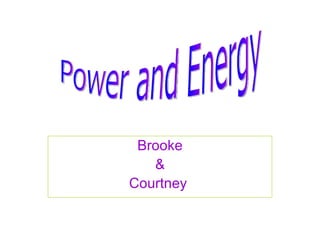power and energy
•
0 gostou•4 visualizações
good project
Denunciar
Compartilhar
Denunciar
Compartilhar
Baixar para ler offline

Recomendados
Recomendados
Mais conteúdo relacionado
Semelhante a power and energy
Semelhante a power and energy (20)
Renewable and non renewable resources for class 10 {PHYSICS}

Renewable and non renewable resources for class 10 {PHYSICS}
Último
Falcon stands out as a top-tier P2P Invoice Discounting platform in India, bridging esteemed blue-chip companies and eager investors. Our goal is to transform the investment landscape in India by establishing a comprehensive destination for borrowers and investors with diverse profiles and needs, all while minimizing risk. What sets Falcon apart is the elimination of intermediaries such as commercial banks and depository institutions, allowing investors to enjoy higher yields.Unveiling Falcon Invoice Discounting: Leading the Way as India's Premier Bill...

Unveiling Falcon Invoice Discounting: Leading the Way as India's Premier Bill...Falcon Invoice Discounting
Falcon stands out as a top-tier P2P Invoice Discounting platform in India, bridging esteemed blue-chip companies and eager investors. Our goal is to transform the investment landscape in India by establishing a comprehensive destination for borrowers and investors with diverse profiles and needs, all while minimizing risk. What sets Falcon apart is the elimination of intermediaries such as commercial banks and depository institutions, allowing investors to enjoy higher yields.Falcon Invoice Discounting: The best investment platform in india for investors

Falcon Invoice Discounting: The best investment platform in india for investorsFalcon Invoice Discounting
Último (20)
HomeRoots Pitch Deck | Investor Insights | April 2024

HomeRoots Pitch Deck | Investor Insights | April 2024
Mifepristone Available in Muscat +918761049707^^ €€ Buy Abortion Pills in Oman

Mifepristone Available in Muscat +918761049707^^ €€ Buy Abortion Pills in Oman
Call 7737669865 Vadodara Call Girls Service at your Door Step Available All Time

Call 7737669865 Vadodara Call Girls Service at your Door Step Available All Time
New 2024 Cannabis Edibles Investor Pitch Deck Template

New 2024 Cannabis Edibles Investor Pitch Deck Template
Unveiling Falcon Invoice Discounting: Leading the Way as India's Premier Bill...

Unveiling Falcon Invoice Discounting: Leading the Way as India's Premier Bill...
Over the Top (OTT) Market Size & Growth Outlook 2024-2030

Over the Top (OTT) Market Size & Growth Outlook 2024-2030
Paradip CALL GIRL❤7091819311❤CALL GIRLS IN ESCORT SERVICE WE ARE PROVIDING

Paradip CALL GIRL❤7091819311❤CALL GIRLS IN ESCORT SERVICE WE ARE PROVIDING
Falcon Invoice Discounting: The best investment platform in india for investors

Falcon Invoice Discounting: The best investment platform in india for investors
Horngren’s Cost Accounting A Managerial Emphasis, Canadian 9th edition soluti...

Horngren’s Cost Accounting A Managerial Emphasis, Canadian 9th edition soluti...
Pre Engineered Building Manufacturers Hyderabad.pptx

Pre Engineered Building Manufacturers Hyderabad.pptx
TVB_The Vietnam Believer Newsletter_May 6th, 2024_ENVol. 006.pdf

TVB_The Vietnam Believer Newsletter_May 6th, 2024_ENVol. 006.pdf
Lundin Gold - Q1 2024 Conference Call Presentation (Revised)

Lundin Gold - Q1 2024 Conference Call Presentation (Revised)
power and energy
- 2. Biomass • Biomass includes the use of food and wood. Energy stored in non-fossil organic materials such as wood, straw, vegetable oils and wastes from the forest, agricultural and industrial sectors. Biomass is one of the most important renewable energy forms and its use in Canada involves both the oldest and the newest of energy technologies. • Biomass is captured from forest industries. To capture energy from biomass is to burn it, to make heat, steam, and electricity.
- 4. Fossil Fuels • Fossil Fuels include different types of oil, gas and jet fuel. They are normally ‘natural resources’ and are extracted from the earth itself. Non-renewable resources. Fossil Fuels may also be associated with mineral fuels. The resources may be crushed, burnt, or turned into steam. • Fossil Fuels form from the organic remains of prehistoric plants and animals.
- 6. Hydroelectric Energy • Hydroelectric Energy produces energy through power plants, some such as; Micro-scale, small-scale and “run-of-the-river.” A dam is built to trap water, usually in a valley where there is an existing lake. Water is allowed to flow through tunnels in the dam, to turn turbines and thus drive generators. Notice that the dam is much thicker at the bottom than at the top, because the pressure of the water increases with depth. • Hydro-electric power stations can produce a great deal of power very cheaply.
- 8. Nuclear Energy • Nuclear Energy work by thermal nuclear reactors and fast reactors. The thermal ones use a moderator to slow down the neutrons produced by fission. The moderator can be normal water, heavy water, or graphite. The normal water types are the Pressurized Water Reactor and Boiling Water Reactor. Fast reactors don't have a moderator, and therefore cannot be built with a water filled core, so have used liquid metal, usually sodium, as coolant.
- 10. Solar Energy • Solar Energy, radiant light and heat from the sun, has been harnessed by humans since ancient times using a range of ever-evolving technologies. Solar powered electrical generation relies on heat engines and photovoltaic. Solar energy's uses are limited only by human ingenuity. A partial list of solar applications includes space heating and cooling through solar architecture, potable water via distillation and disinfection, day lighting, solat hot water, solar cooking, and high temperature process heat for industrial purposes. To harvest the solar energy, the most common way is to use solar panels.
- 12. Wind Energy • Wind energy is energy obtained from moving air. is the conversion of wind energy into a useful form of energy. Some such as using wind turbines to make electricity, wind mills for mechanical power, wind pumps for pumping water or drainage, or sails to propel ships. • The motion results from the heating and cooling of the Earth.
- 14. Geothermal Energy • Geothermal Energy is power extracted from heat stored in the earth. Geothermal power is cost effective, reliable, sustainable, and environmentally friendly, but has historically been limited to areas near tectonic plate bouneries. • This geothermal energy originates from the original formation of the planet, from radioactive decay of minerals, and from solar energy absorbed at the surface.